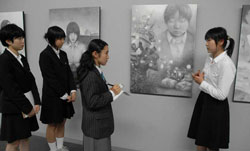
Students in the course explaining their work to the junior writer (third from the left).

縲窶廬n this painting, I窶冦 praying for the souls of the dead in war and expressing my wish for a hopeful future,窶・said Natsumi Morita, 17, whose self-portrait shows the image of herself holding a candle in a wide, burnt wasteland. Megumi Tanaka, 18, based her own self-portrait on the question, 窶弩hat can I do for peace?窶・/p>
縲These paintings were created in a course that began six years ago. Students at that time often spontaneously chose peace as a theme for their work, so peace became the official theme three years ago.
縲Inspiration for the paintings comes from war-related movies or books and sometimes includes their grandparents窶・stories about their war experience. After clarifying the image for their paintings, it takes about one month to finish these works of B1 size (103cm テ・2.8cm).
縲For Eri Kanomaru, 17, her grandparents窶・words 窶弋here窶冱 little freedom during war窶・prompted the idea, 窶弩e should appreciate that we live each day in freedom.窶・So she painted herself taking a deep breath.
縲These self-portraits will be shown at an exhibition in Hiroshima in August and the artists hope that visitors will reflect on peace as they look at the paintings. Then, after the exhibition, a catalogue of the artwork will be produced.(Yuki Sakata, 13)
縲Since 1984, when he established the group 窶弋alk about Hiroshima,窶・Hiroshi Hara has painted 1950 pictures of the A-bomb Dome. He then donates these paintings to elementary schools and junior high schools where he talks about his experience as a survivor of the bombing.
縲First, he makes a sketch of the dome with a ball-point pen. Since a sketch in pen is permanent, this technique concentrates his desire to forcefully express the idea that 窶徂uman beings and nuclear weapons cannot co-exist窶・
縲Next, he uses watercolors to add light color to the image. The fact that he saw such harsh colors in Hiroshima the day after the bombing-the charred corpses and burning ruins-has made him choose 窶徭oft colors窶・for his work.
縲Though Mr. Hara has been hospitalized twice, in 2002 and 2003, the 窶徘ower from the A-bomb Dome窶・enables him to continue painting. He says, 窶廴y mission is to pass on the call of the A-bomb Dome to the next generation.窶・His present goal is to complete 2000 paintings by August 6 of this year. (Reika Konno, 12)
縲Taro Okamoto (1911-1996) is a famous Japanese painter and 窶廴yth of Tomorrow窶・is a masterpiece that depicts the bombing. It is currently on display at the Museum of Contemporary Art in Tokyo.
縲This huge mural (5.5m x 30m) was painted in Mexico in 1968-69, but it went missing for many years. It was rediscovered in 2003 and returned to Japan. The owner of the mural, The Taro Okamoto Memorial Foundation, is now pondering a permanent home for the mural.
縲The people of Hiroshima are actively engaged in bringing the mural to Hiroshima. Last year a group was formed to work towards this goal and, on May 22nd, they presented the Mayor of Hiroshima with a petition that had 27,503 signatures and urged him to lobby for the mural窶冱 move to Hiroshima. A representative of the group, Yoshimichi Ishimaru, says, 窶廩iroshima is the natural home for this mural. We will continue our activities with this aim in mind.窶・/p>
縲Since 1999, Masaru Tanaka has been involved in creative work with Betsie Miller-Kusz, 62, whose father was part of the Manhattan Project which produced the atomic bombs. He calls this work 窶弃roject for a New Peace Century窶・
縲He integrates his photos with Ms. Miller-Kusz窶冱 paintings, expressing the idea that human beings can overcome conflict and work together to create peace. So far, they have collaborated on 63 pieces, including 窶廴OTHER窶・which depicts the United States after the terrorist attack and 窶弩hite Rain窶・which was set in Peace Memorial Park.
縲窶彝oof Tiles from the Bombing窶・is a painting which shows the roof tiles that were blown off his house by the blast. They melted in the heat of the explosion and hardened into strange forms. In the background is the A-bomb Dome, the Children窶冱 Peace Monument, and origami cranes in flight. In this painting, Mr. Seko expressed his wish for no more such tragedies in the world.
縲When the atomic bomb fell, he was just three years old. At the time, he had been evacuated to the countryside to avoid air attacks, but he says, 窶廬 can still clearly recall the many wounded who were carried our way from the city.窶・/p>
縲Since the second year of the Hiroshima Peace Art Exhibition, in 1956, Shiro Shirai窶冱 paintings have been displayed at this exhibition each year. Last year, he created a painting which depicted the image of three grieving souls in black rain, who lost their family in the bombing.
縲His paintings are inspired by his own experience: watching the mushroom cloud in Hatsukaichi, near Hiroshima, and his older brother who was burned in the blast.
縲To share his thoughts with children, he published a children窶冱 book in 1989. The book tells the story of a monkey and a little girl and the monkey eventually dies as a result of the bombing. He also lends the original paintings for this book to local community centers.
縲Over the past three years, 60 portraits of A-bomb survivors have been created by students, teachers, and alumni of Hiroshima City University. Each portrait is displayed with text which shares the person窶冱 memories of the bombing and their life afterwards.
縲Professor Hideo Oya of the Faculty of Art painted a woman who had been a student at the time of the bombing. She gave a vivid account of her experience: after seeing the flash, she was blown by the blast and her clothes were scorched.
縲These 60 portraits include the children and grandchildren of A-bomb survivors.
窶サClick to view larger images and read the personal stories of the models (Japanese only).